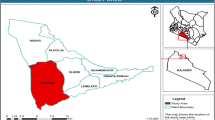Abstract
Lythrum salicaria (purple loosestrife) is a perennial herbaceous plant that was introduced in the 1800s into North America. Its geographical expansion has generated much concern. in part because its spread may lead to a reduction in the diversity of plant species in wetlands. We tested this hypothesis by examining the association between the abundance ofLythrum salicaria and vascular plant species richness in forty-one 2m × 2m plots located along the Bar River, Ontario, Canada. No significant differences in mean species richness were found between plots with and withoutL. salicaria. For those plots containingL. salicaria, species richness was not related to the percentage cover ofL. salicaria. Furthermore, there were no significant differences in the number of introduced plant species between plots with and withoutL. salicaria, nor were there differences with increasing percent cover ofL. salicaria. Plant species such asNuphar variegatum. Scirpus atrovirens, Scirpus cyperinus, andScirpus microcarpus were more likely to be found in plots withLythrum salicaria than without. However, no plant species were significantly more likely to be found in plots withoutLythrum salicaria than with it. Collectively, these results provide no support for the hypothesis that the number of species in wetlands is decreasing in association with the invasion ofLythrum salicaria in Ontario.
Similar content being viewed by others
Literature Cited
Anderson, M. G. 1991. Population structure ofLythrum salicaria in relation to wetland community type. M. Sc. thesis, Department of Plant Biology. University of New Hampshire, Durham, NH, USA.
Anderson, M. G. 1995. Interactions betweenLythrum salicaria and native organisms: a critical review. Environmental Management 19:225–231.
Barbour, M. G., J. H. Burk, and W. D. Pitts. 1980. Terrestrial Plant Ecology. Benjamin/Cummings Publishing Co. Inc. Menlo Park, CA, USA.
Bowen, K. 1998. Beetles offer hope for purple loosestrife control. Pappus 17:21–27.
Burke, M. J. W. and J. P. Grime. 1996. An experimental study of plant community invasibility. Ecology 77:776–790.
Emery, S. L. and J.A. Perry. 1995. Aboveground biomass and phosphorous concentrations ofLythrum salicaria (purple loosestrife) andTypha spp. (cattail) in 12 Minnesota wetlands. American Midland Naturalist 134:394–399.
Fernald, M. L. 1940. The problem of conserving rare native plants. p. 375–391. Annual report of the Smithsonian Institution, Washington, DC, USA.
Gaudet, C. L. and P. A. Keddy. 1988. A comparative approach to predicting competitive ability from plant traits. Nature 334:242–243.
Gleason, H. A. and A. Cronquist. 1991: Manual of Vasculan Plants of Northeastern United States and Adjacent Canada. 2nd. Edition. New York Botanical Garden, New York, NY, USA.
Hager, H. A. and K. D. McCoy. 1998. The implications of accepting untested hypotheses: a review of the effects of purple loosestrife (Lythrum salicaria) in North America. Biodiversity and Conservation, in press.
Hight, S. D. and J. J. Drea, Jr. 1991. Prospects for a classical biological control project against purple loosestrife (Lythrum salicaria L.). Natural Areas Journal 11:151–157.
Hobbs, R. J. and L. Atkins. 1988. Effect of disturbance and nutrient addition on native and introduced annuals in plant communities in the Western Australian wheatbelt. Australian. Journal of Ecology 13:171–179.
Johansson, M. E. and P. A. Keddy. 1991. Intensity and asymmetry of competition between plant pairs of different degrees of similarity: an experimental study on two guild of wetland plants. Oikos 60:27–34.
Mal, T. K., J. Lovett-Doust, L. Lovett-Doust, and G. A. Mulligan. 1992. The biology of Canadian weeds. 100.Lythrum salicaria. Canadian Journal of Plant Science 72:1305–1330.
Morton, J. K. and J. M. Venn. 1990. A checklist of the flora of Ontario vascular plants. Department of Biology, University of Waterloo, Waterloo, ON, Canada.
Novak, L. C. 1967. Mechanical control of purple loosestrife. Report of wildlife management study, No. 1, Great Meadows NWR, Sudbury, MA, USA.
Rawinski, T. J. 1982. Ecology and management of purple loosestrife in central New York. M.Sc. Thesis. Cornell University, Ithaca, NY, USA.
Shamsi, S. R. A. and F. H. Whitehead. 1974a. Comparative ecophysiology ofEpilobium hirsutum andLythrum salicaria 1. Journal of Ecology 62:279–290.
Shamsi, S. R. A. and F. H. Whitehead. 1974b. Comparative ecophysiology ofEpilobium hirsutum andLythrum salicaria 2. Journal of Ecology 62:632–645.
Shamsi, S. R. A. and E. H. Whitehead. 1977a. Comparative ecophysiology ofEpilobium hirsutum andLythrum salicaria 3. Journal of Ecology 65:55–70.
Shamsi, S. R. A. and F. H. Whitehead. 1977b. Comparative ecophysiology ofEpilobium hirsutum andLythrum salicaria. Journal of Ecology 65:71–84.
Steel, R. G. D. and J. H. Torrie. 1980. Principles and Procedures of Statistics: a Biometrical Approach. 2nd. Edition. McGraw-Hill, New York, NY, USA.
Stuckey, R. L. 1980. Distributional history ofLythrum salicaria (purple loosestrife) in North America. Bartonia 47:3–20.
Thompson, D. Q. 1991. History of purple loosestrife (Lythrum salicaria L.) biological control efforts. Natural Areas Journal 11: 148–150.
Thompson, D. Q., R. L. Stuckey, and E. B. Thompson. 1987. Spread, impact, and control of purple loosestrife (Lythrum salicaria) in North American wetlands. U.S. Fish and Wildlife Service, Washington, DC, USA., Fish and Wildlife Research No. 2.
Torrey, J. and A. Gray. 1840. A Flora of North American. Vol. 1. Wiley and Putnam, New York, NY, USA.
White, D. J., E. Haber, and C. Keddy. 1993. Invasive Plants of Natural Habitats in Canada. p. 38–44.In Report for Canadian Wildlife Service. Environment Canada, Ottawa, ON, Canada.
Zar, J. H. 1984. Biostatistical Analysis. Second ed. Prentice Hall. Englewood Cliffs, NJ, USA.
Author information
Authors and Affiliations
Corresponding author
Rights and permissions
About this article
Cite this article
Treberg, M.A., Husband, B.C. Relationship between the abundance ofLythrum salicaria (purple loosestrife) and plant species richness along the Bar River, Canada. Wetlands 19, 118–125 (1999). https://doi.org/10.1007/BF03161740
Received:
Revised:
Accepted:
Issue Date:
DOI: https://doi.org/10.1007/BF03161740




